Suchergebnisse
Parametrische Planung für ein Nachhaltiges Nutzdach (Blau, Grau und Grün) – NaNu3
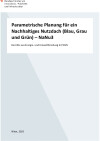
Aufzeigen der Machbarkeit und Validierung eines Parametrischen Modelles, das in einem frühen Planungsstadium die kombinierte Nutzung von Dachflächen auf ihre praktische und finanzielle Umsetzbarkeit und Mikroklima- und Umweltwirksamkeit überprüfen kann.
Schriftenreihe
47/2025
Martin Jung, Theresa Fink, Paul Kinner, Karl Berger, Shokufeh Zamini, Marcus Rennhofer, Paul Erian, Antonija Wieser, Susanne Formanek, Isabelle Haymerle, Franz Dolezal, Philipp Boogman, Petra Gruber
Herausgeber: BMIMI
Deutsch, 47 Seiten
Downloads zur Publikation
Energieoptimierte Design-Regeln und Planungsschnittstellen für bauwerkintegrierte Photovoltaik im urbanen Raum (VITALITY)
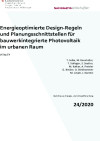
Das Projekt VITALITY zielte darauf ab, unterstützende Instrumente, Designregeln und belastbare Informationen in der frühen Entscheidungs- und Entwurfsphase von Bauvorhaben zu liefern, um bauwerkintegrierte Photovoltaik (BIPV) einerseits in die Diskussion der Konzeptphase einzubringen und andererseits die Umsetzung stark vorzubereiten und zu unterstützen.
Schriftenreihe
24/2020
T. Selke, M. Rennhofer, T. Schlager, S. Sautter, M. Kaftan, A. Preisler G. Becker, O. Stelzhammer M. Lovati, J. Kanters
Deutsch, 57 Seiten
Downloads zur Publikation
Umsetzung regionaler Elektromobilitätsversorgung durch hybride Kopplung (Move2Grid)
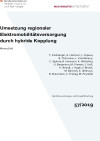
Aufbauend auf den Ergebnissen der „Stadt der Zukunft“ Sondierungsprojekte „Smart Exergy Leoben“, und „Energieschwamm Bruck“ soll im gegenständlichen,umsetzungsorientierten Forschungsvorhaben anhand des Beispiels Leoben untersucht werden, wie mit regionalen, erneuerbaren Ressourcen regionale Elektromobilität langfristig versorgt, optimal ins kommunale Verteilernetzsystem integriert und ökonomisch nachhaltig implementiert werden kann.
Schriftenreihe
57/2019
T. Kienberger, A. Hammer, J. Vopava, B. Thormann, L. Kriechbaum, C. Sejkora, R. Hermann, K. Watschka, U. Bergmann, M. Frewein, J. Koß, H. Brandl, J. Vogel, S. Moser, M. Baresch, K. de Bruyn, R. Braunstein, C. Freitag, M. Peyreder
Herausgeber: BMVIT
Deutsch, 172 Seiten
Downloads zur Publikation
LehB:klimafit! Lebe heute im Bestand: Zusammen klimafit
Ziel des Projekts ist die Sondierung von übertragbaren Sanierungskonzepten für die Umsetzung von klimafitten Sanierungen in Wien. Es werden integral optimierte Sanierungspakete entwickelt, die in den Gebäudeensembles auf umsetzungswahrscheinliche, klimafitte Gesamtlösungen mit den relevanten Stakeholder:innen hin optimiert werden.
Urbane Grünraumpotenziale iM verBauten BestAnd (Urbane GmbA)
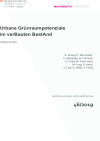
Urbane GmbA hat zum Ziel, das Grünflächenpotenzial am Gebäude- und im verbauten Bestand (vertikal und horizontal) in Wien zu sondieren, verfügbare Erhebungsinstrumente in den Projektgebieten anzuwenden und Forschungs- und Entwicklungsbedarfe für grüne Infrastrukturen aufzuzeigen.
Schriftenreihe
46/2019
R. Stangl, P. Minixhofer, S. Hörbinger, G. Frühwirt, U. Pitha, W. Friesl-Hanl, M. Jung, G. Heiss, V. Enzi, G. Hofer, J. Preiss
Herausgeber: BMVIT
Deutsch, 133 Seiten
Downloads zur Publikation
PEQBacker: Integrative Quartiersplanung - Enabler auf dem Weg zum Plus-Energie-Quartier
Entwicklung von Leitlinien zur Implementierung von Koordinationsstellen für Plus-Energie-Quartiere auf Basis der Recherche von Erfolgsfaktoren, der Sondierung von fehlenden Elementen bestehender Strukturen und der Konsultation einer breiten Stakeholdergruppe mit dem Ziel, die Transformation von bestehenden und entstehenden Quartieren Richtung Plus-Energie-Quartiere zu erhöhen.
PEQBacker: Integrated District Planning - Enabler on the way to a Plus-Energy District
Development of guidelines for the implementation of Plus-Energy District coordination units based on research of success factors, exploration of mission elements of existing structures and consultation of a broad stakeholder group with the goal of increasing the transformation of existing and emerging neighbourhoods toward Plus-Energy Districts.
Enerspired Cities - offene harmonisierte Informationsgrundlagen für die energieorientierte Stadtplanung
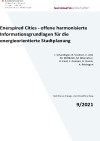
In "Enerspired Cities" wird das Konzept für eine automatisierte Zusammenführung und rechtlich abgesicherte Zugriffssteuerung zu energieräumlich relevanten Datensätzen erarbeitet. Dieses wird in den Städten Innsbruck, Salzburg und Wien an die jeweilig anzutreffende Situation angepasst und in individuellen Pilotanwendungen umgesetzt. Ziel ist die Unterstützung von Stadtplanungs-, Monitoring- und Forschungsvorhaben durch eine einfache und transparente Bereitstellung von Basisdaten aus unterschiedlichsten Quellen für eine breite Schicht von Nutzern.
Schriftenreihe
9/2021
I. Schardinger, B. Vockner, C. Atzl, M. Mittlböck, M. Biberacher, H. Kinzl, L. Gamper, H. Hemis, A. Rehbogen
Herausgeber: BMK
Deutsch, 90 Seiten
Downloads zur Publikation
GreenTech-Renovation - Energetische Sanierung von gläsernen Gebäuden von architektonischem Wert
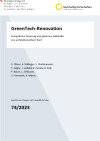
Der Schwerpunkt des Projekts GreenTech-Renovation war, innovative Lösungen zur energetischen Sanierung von architektonisch wertvollen Bauten mit hohen Glasanteil zu finden. Dafür wurde ein zukunftsweisendes bauphysikalisches Konzept entwickelt, das den Einsatz alternativer Energieformen beinhaltet. Ein intelligentes Nutzungskonzept kann mit ökologischem und sozialem Engagement die energetischen Sanierungskonzepte verstärken und deren Nachhaltigkeit garantieren. Die 10-R der Kreislaufwirtschaft (Refuse, Rethink, Reduce, Reuse, Repair, Refurbish, Remanufacture, Repurpose, Recycle, Recover) dienen dabei als Leitlinie.
Schriftenreihe
74/2023
S. Tillner, A. Willinger, S. Stockhammer, T. Zelger, J. Leibold, E. Paráda, D. Bell, P. Bauer, L. Zeilbauer, S. Formanek, K. Mauss, B. Lipp, T. Dobra
Herausgeber: BMK
Deutsch, 152 Seiten
Downloads zur Publikation
Energieschwamm Bruck
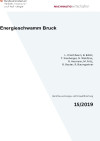
Im Sondierungsprojekt für die Stadtregion Bruck/Oberaich "Energieschwamm Bruck" wurden klare Grundlagen zur Entwicklung und Flexibilisierung des zukünftigen kommunalen Energiesystems in Form eines Energieentwicklungskonzeptes und eines Katasters möglicher Umsetzungsprojekte erarbeitet. Aus dem für Bruck angewendeten, strukturellen Lösungsprozess wurde eine allgemein gültige Lösungsmethode für Städte mit 10.000-25.000 Einwohnern abgeleitet.
Schriftenreihe
15/2019
L. Kriechbaum, B. Böckl, T. Kienberger, N. Wohltran, R. Hermann, M. Fritz, R. Rauter, R. Baumgartner
Herausgeber: BMVIT
Deutsch, 62 Seiten
Downloads zur Publikation
VITALITY - Energieoptimierte Design-Regeln und Planungsschnittstellen für BIPV im urbanen Raum
Das Projekt VITALITY zielte darauf ab, unterstützende Instrumente, Designregeln und belastbare Informationen in der frühen Entscheidungs- und Entwurfsphase von Bauvorhaben zu liefern, um bauwerkintegrierte Photovoltaik (BIPV) einerseits in die Diskussion der Konzeptphase einzubringen und andererseits die Umsetzung stark vorzubereiten und zu unterstützen.
VITALITY - Energy optimised design rules and integral planning approach for building-integrated photovoltaics in urban areas
The VITALITY project aims to provide supporting tools, design rules and robust information in the early decision and design phase of building projects. By providing the right information at the right time, building-integrated photovoltaics (BIPV) is part of the discussion in the concept phase and the implementation is strongly prepared and supported.
INFINITE: INnovative FINanzierungsmodelle für nachhaltige urbane EnergIesysTEme
Ziel des INFINITE-Projekts ist es, in Stadtentwicklungsgebieten die gebäudeübergreifende Versorgung mit erneuerbaren Energieträgern durch lokale Versorgungseinheiten (lokale EVU’s) voranzutreiben und damit den Bedarf an fossilen Energieträgern, sowie überregionaler Energieversorgungsinfrastruktur zu reduzieren.
INFINITE: INnovative FINancing models for sustaInable urban energy sysTEms
The goal of the INFINITE-project is to lay the foundations for a more wide-spread implementation of urban energy supply systems across buildings, using renewable energy sources produced in local supply units. At the same time the projects supports to reduce the demand for fossil fuels and higher-level energy infrastructure.
Raum & Grün - Möglichkeiten zur Integration von Begrünung ins Regelwerk der österreichischen Raumordnung
In der F&E-Dienstleistung „Raum & Grün“ wurde eine Studie erstellt, welche die Zusammenhänge zwischen Raumordnung und Begrünung abbildet, den Handlungsbedarf sowie -spielraum von Akteurinnen und Akteuren zeigt sowie konkrete Empfehlungen formuliert, wie innovative Stadtbegrünungen und Bauwerksbegrünungen effektiv in das Regelwerk der österreichischen Raumordnung und Raumplanung verankert werden können.
KoPro Lzk+ - Kosten- und Prozessoptimierung im Lebenszyklus von Niedrigst- und Plusenergiegebäuden
Ziel des Projekts war es, einen durchgängigen Prozess zur energetisch-wirtschaftlichen Optimierung von Null- und Plusenergiegebäuden in allen Planungsphasen vom regionalen Entwicklungskonzept bis zum Rückbau des Gebäudes zu entwickeln, für die planungsbegleitenden Akteure aufzubereiten und online zur Verfügung zu stellen. Neben der Beschreibung des durchgängigen Planungsprozesses werden wichtige Kostenkenngrößen und Einsparpotenziale in einer Datenbank verfügbar gemacht.
KoPro Lzk+ - Cost and process optimization in the life cycle of nearly zero energy buildings
The aim of the project was to develop a continuous process chain for the energetic-economic optimization of zero and plus energy buildings. The project focused on proven and new approaches to cost reduction of nearly zero energy buildings (nZEBs) at all stages of the life cycle. The main goal was to identify the extra-costs for nZEBs, and to promote innovative approaches taking into account the cost-effectiveness for all the Stakeholders. A database containing important cost parameters and potential savings will be developed.
F4WM - Fit4WienerMission
Vorbereitung auf die EU Urban Mission durch Aktualisierung von Zielen und Strategien (Smart City Wien Rahmenstrategie, Klima-Roadmap), Erarbeitung eines Manuals für klimaneutrale Wiener Grätzl und Grobkonzepte für die Beteiligung von Bürger:innen (Klima-Bürger:innenrat) und Wirtschaftstreibenden (Klima-Agreements), sowie einer stadtinternen Kapazitäten- und Strukturplanung.
F4WM - Fit4WienerMission
Preparation for the EU Urban Mission by updating goals and strategies (Smart City Wien Framework strategy, Climate-Roadmap), developing a manual for climate-neutral Viennese neighbourhoods and concepts for the participation of citizens (Climate Citizens' Council) and businesses (Climate Agreements), as well as a city-internal capacity and structural planning.
Move2Grid – Implementation of regional energy-supply-concepts by hybrid coupling
Based on the results of the national-funded exploratory projects called “Smart Exergy Leoben”, and “Energy Sponge Bruck”, the present implementation project aims at analysing how local, renewable resources support the supply of electric mobility in Leoben in the long term and to integrate it into the municipal distribution grid in a good economic sense.
